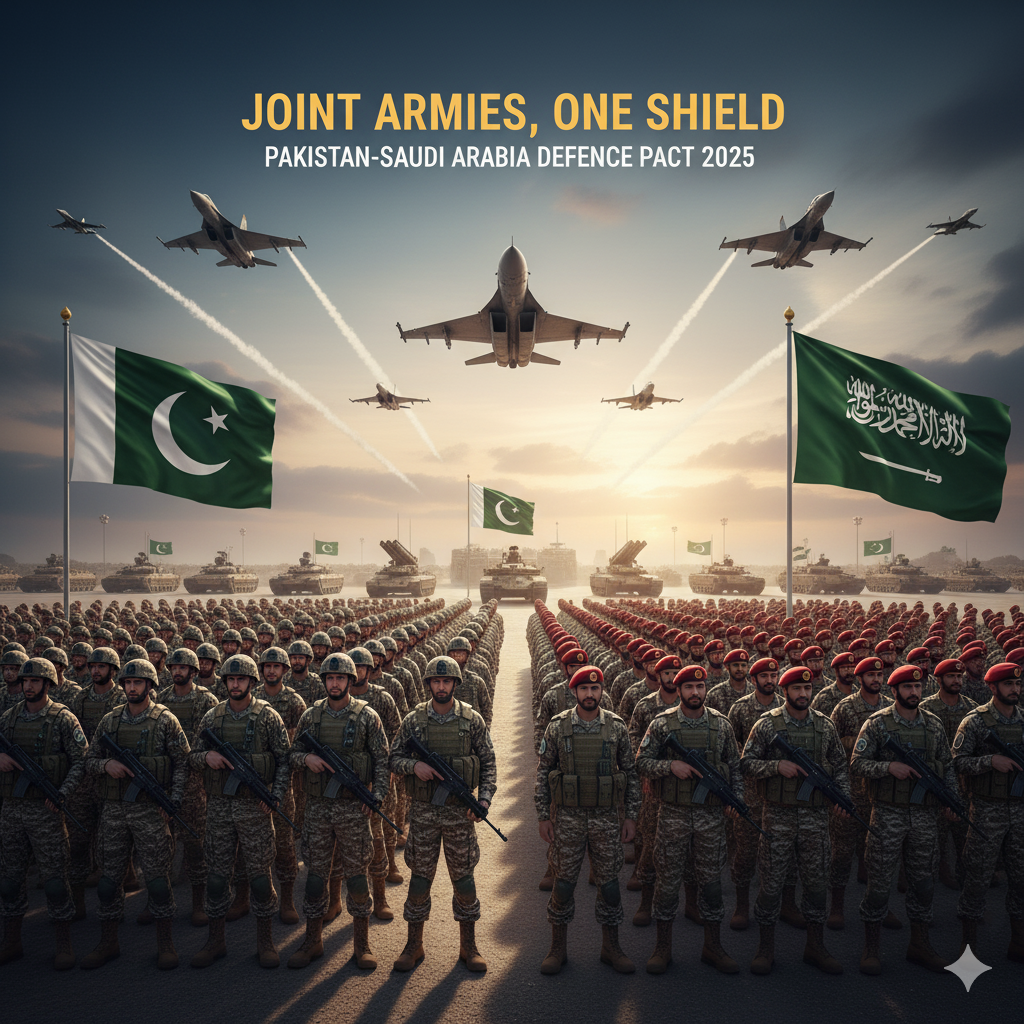Introduction
The recent signing of the Pakistan–Saudi Arabia Defence Pact, officially called the Strategic Mutual Defence Agreement (SMDA), has emerged as one of the most significant geopolitical developments of 2025. The pact, sealed at Al-Yamamah Palace in Riyadh during the state visit of Prime Minister Shehbaz Sharif and Crown Prince Mohammed bin Salman (MBS), carries a historic clause: “an attack on one shall be considered an attack on both.”
This landmark mutual defence agreement not only deepens defence cooperation between Pakistan and Saudi Arabia but also signals a geopolitical shift that will reshape South Asia and the Middle East’s security landscape.
Key Clauses of the Strategic Mutual Defence Agreement
At its core, the Pakistan–Saudi Arabia defence pact enshrines the principle of joint deterrence. The most talked-about clause is the attack on one is attack on both provision, which effectively binds the two countries to respond collectively to any aggression against either side.
Other important aspects include:
- Expansion of military cooperation through joint military exercises, intelligence sharing, and training programs.
- Potential alignment of defence spending and military modernization strategies.
- Enhanced security coordination in light of regional threats.
Pakistan’s Nuclear Deterrence and the Saudi Factor
One of the most widely debated questions surrounding this pact is whether Saudi Arabia now falls under Pakistan’s nuclear deterrent. While official statements have avoided explicit confirmation, analysts argue that the pact creates a form of strategic ambiguity—suggesting that Saudi Arabia may benefit from Pakistan’s nuclear umbrella in the event of a major security crisis.
This dimension alone elevates the agreement’s global significance, as it indirectly ties a nuclear-armed Pakistan to the security of one of the most influential Gulf monarchies.
Historical Context: Decades of Pakistan–Saudi Military Cooperation
The pact is not emerging in isolation. Pakistan and Saudi Arabia share a long history of defence cooperation, including:
- Deployment of Pakistani troops in the Kingdom since the 1970s.
- Saudi funding support for Pakistan during critical phases of its military development.
- Regular joint military exercises that strengthened operational compatibility.
By formalizing this relationship in the form of a mutual defence agreement, the two nations have effectively institutionalized what was previously a series of bilateral understandings.
Regional Security Implications
1. Impact on India
For India, this pact is a matter of concern. It potentially complicates the security calculus in South Asia, as Saudi Arabia’s alignment with Pakistan could strengthen Islamabad’s hand in regional disputes.
2. Iran and the Gulf Equation
Iran, already wary of Saudi Arabia’s regional influence, is likely to view the pact as a direct security challenge. Given Pakistan’s delicate balancing act between Saudi Arabia and Iran, this agreement could test Islamabad’s diplomatic flexibility.
3. Israel and Western Interests
Western powers, particularly the United States, are watching closely. Some analysts suggest that the mutual defence pact could influence Saudi Arabia’s pace of normalization with Israel.
Strategic Signalling and Islamic Solidarity
Officials on both sides describe the pact as a reflection of Islamic solidarity and shared strategic interests. By framing the agreement within the broader concept of brotherhood, leaders in Riyadh and Islamabad are sending a message not only to their adversaries but also to their allies: the relationship is no longer transactional but rooted in mutual trust and security commitments.
What Sets This Pact Apart?
Unlike previous memoranda or defence agreements in the region, the Pakistan–Saudi Arabia defence pact is distinct because:
- It formalizes the collective defence clause, a concept often associated with NATO.
- It carries deliberate ambiguity on whether nuclear deterrence applies, keeping rivals guessing.
- It opens the door for other Arab nations to join, potentially creating a multi-nation security framework led by Saudi Arabia and Pakistan.
Reactions and Future Outlook
Reactions from the region have been mixed:
- Pakistan’s government and media hail it as a historic step for security and foreign policy.
- Saudi commentators emphasize its role in ensuring stability and protecting national interests.
- India and Iran are approaching the pact cautiously, assessing its long-term implications.
Moving forward, the implementation of joint defence mechanisms—such as future military drills, intelligence exchanges, and defence spending alignments—will determine the actual strength of this alliance.
Conclusion
The Pakistan–Saudi Arabia Strategic Mutual Defence Agreement marks a turning point in regional security dynamics. By declaring that “an attack on one is an attack on both,” Islamabad and Riyadh have committed to a path of joint deterrence, strategic cooperation, and shared defence responsibilities.
Beyond symbolism, this pact redefines how South Asia and the Middle East will respond to future conflicts. Whether it leads to greater stability or intensifies geopolitical tensions remains to be seen. But one thing is certain: the Pakistan–Saudi Arabia defence pact has firmly established itself as a historic milestone in modern international relations.







